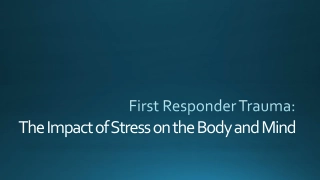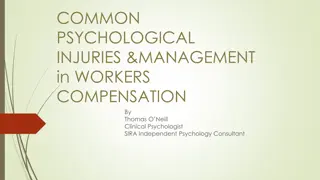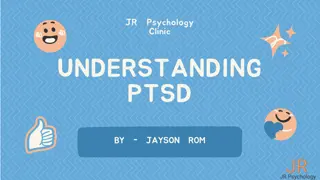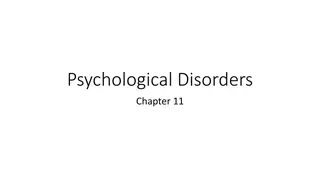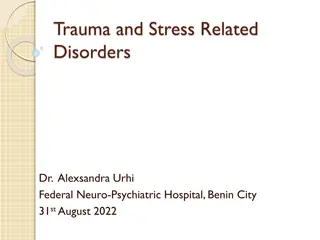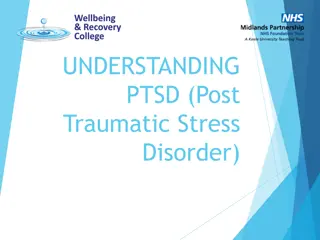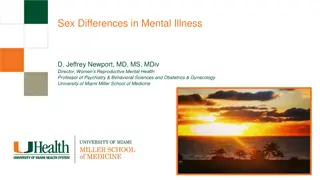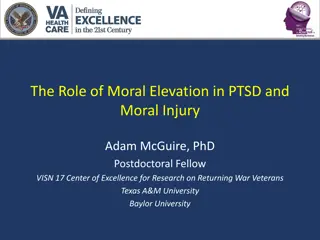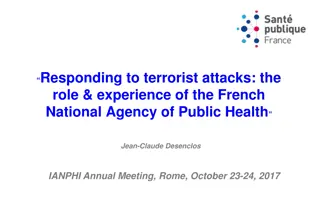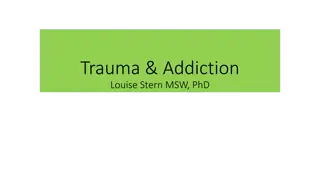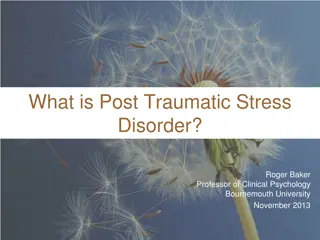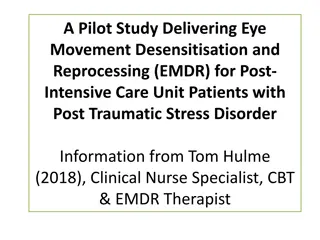
Identification, Assessment, and Treatment of PTSD in Schools
Explore the prevalence of PTSD among school-age youth, the role of school-based mental health professionals, and seminar objectives related to recognizing, assessing, and responding to PTSD in educational settings.
Download Presentation

Please find below an Image/Link to download the presentation.
The content on the website is provided AS IS for your information and personal use only. It may not be sold, licensed, or shared on other websites without obtaining consent from the author. If you encounter any issues during the download, it is possible that the publisher has removed the file from their server.
You are allowed to download the files provided on this website for personal or commercial use, subject to the condition that they are used lawfully. All files are the property of their respective owners.
The content on the website is provided AS IS for your information and personal use only. It may not be sold, licensed, or shared on other websites without obtaining consent from the author.
E N D
Presentation Transcript
The Identification, Assessment, and Treatment of PTSD at School Stephen E. Brock, Ph.D., NCSP California State University, Sacramento 1
Preface Adapted from Nickerson, A. B., Reeves, M. A., Brock, S. E., & Jimerson, S. R. (2009). Assessing, identifying, and treating posttraumatic stress disorder at school. New York: Springer. Brock, S. E., Nickerson, A. B., Reeves, M. A., Jimerson, S. R., Lieberman, R., & Feinberg, T. (2009). School crisis prevention and intervention: The PREPaRE model. Bethesda, MD: NASP. 2
Preface PTSD necessarily involves exposure to a traumatic stressor. A traumatic stressor can generate initial stress reactions in just about anyone. However, not everyone exposed to these events develops PTSD. Among those who develop PTSD, significant impairments in daily functioning (including interpersonal and academic functioning) are observed. Developmentally younger individuals are more vulnerable to PTSD. 3
Preface Prevalence among school age youth Trauma Exposure = 68% 37% report two or more traumatic events Lifetime prevalence of PTSD = 6 to 10% 30% among some urban populations Berton & Stabb (1996),Buka et al. (2001); Copeland et al. (2007); Dyregrov & Yule (2006); Seedat et al. (2004) 4
Preface The role of the school-based mental health professional is to be able to recognize and screen for PTSD symptoms. aware of the fact PTSD may generate significant school functioning challenges. knowledgeable of effective treatments for PTSD and appropriate local referrals. cognizant of the limits of their training. It is not necessarily to diagnose PTSD. treat PTSD. Cook-Cattone (2004) 5
Seminar Outline Characteristics of PTSD Causes of PTSD Identification/Assessment of PTSD Preventing/Mitigating PTSD Responding to PTSD 6
Seminar Objectives From participation in this workshop participants will 1. be able to recognize the characteristics of PTSD. 2. understand the school psychologist s role in the identification and assessment of PTSD. 3. be able to identify strategies designed to prevent, mitigate, and respond to PTSD. 4. Be better prepared for the Masters Exam. 7
Seminar Outline Characteristics of PTSD DSM-5 Developmental Variations Manifestations at School Causes of PTSD Identification/Assessment of PTSD Preventing/Mitigating PTSD Responding to PTSD 8
Characteristics of PTSD DSM-5 A Trauma- and Stressor-Related disorder that develops secondary to exposure (experiencing, witnessing, or learning about) to an extreme traumatic stressor. An event that involves actual or threatened death or serious injury, or threat to ones physical integrity. APA (2013) 9
Characteristics of PTSD DSM-5 Core Symptoms 1. Intrusion symptoms. 2. Persistent avoidance of stimuli associated with the trauma. 3. Negative alterations in cognitions and mood 4. Alteration in arousal and reactivity. Duration of the disturbance is more than one month. The disturbance causes clinically significant distress or impairment in social, occupational, or other important areas of functioning. APA (2013) 10
Characteristics of PTSD DSM-5 Intrusion Symptoms 1. Recurrent/intrusive distressing memories. 2. Recurrent distressing dreams. 3. Acting/feeling as if the event were recurring. 4. Psychological distress at exposure to cues that symbolize/resemble the traumatic event. 5. Physiological reactivity on exposure to cues that symbolize/resemble the traumatic event. APA (2013) 11
Characteristics of PTSD DSM-5 Avoidance Symptoms 1. Avoids distressing memories, thoughts or feelings 2. Avoids external reminders that arouse distressing memories, thoughts, or feelings APA (2013) 12
Characteristics of PTSD DSM-5 Negative alterations in cognitions and mood 1. Inability to remember an important aspect of the event 2. Persistent and exaggerated negative beliefs or expectations 3. Persistent, distorted cognitions about cause or consequence of the event 4. Persistent negative emotional state 5. Diminished interest/participation in significant activities. 6. Feelings of detachment or estrangement 7. Inability to experience positive emotions APA (2013) 13
Characteristics of PTSD DSM-5 Increased Arousal Symptoms 1. Irritability or outbursts of anger. 2. Reckless/self-distructive 3. Hypervigilance. 4. Exaggerated startle response. 5. Difficulty concentrating. 6. Difficulty falling or staying asleep APA (2013) 14
Characteristics of PTSD DSM-5 PTSD may be specified as Acute Chronic Delayed onset APA (2013) 15
Characteristics of PTSD DSM-5 Associated Features Survivor guilt Impaired social/interpersonal functioning Auditory hallucinations & paranoid ideation Impaired affect modulations Self-destructive and impulsive behavior Somatic complaints (e.g., headaches) Shame, despair, or hopelessness Hostility Social withdrawal APA (2013) 16
Characteristics of PTSD DSM-5 Associated Mental Disorders Major Depressive Disorder Substance-Related Disorders Panic Disorder Agoraphobia Obsessive-Compulsive Disorder Generalized Anxiety Disorder Social Phobia Specific Phobia Bipolar Disorder APA (2013) 17
Characteristics of PTSD Developmental Variations Preschoolers Reactions not as clearly connected to the crisis event as observed among older students. Reactions tend to be expressed nonverbally. Given equal levels of distress and impairment, may not display as many PTSD symptoms as older children. Temporary loss of recently achieved developmental milestones. Trauma related play. APA (2000), Berkowitz (2003), Cook-Cottone (2004), Dulmus (2003), Joshi & Lewin (2004), NIMH (2001), Yorbik et al. (2004) 18
Characteristics of PTSD Developmental Variations School-age children Reactions tend to be more directly connected to crisis event. Event specific fears may be displayed. Reactions are often expressed behaviorally. Feelings associated with the traumatic stress are often expressed via physical symptoms. Trauma related play (becomes more complex and elaborate). Repetitive verbal descriptions of the event. Problems paying attention. APA (2000), Berkowitz (2003), Cook-Cottone (2004), Dulmus (2003), Joshi & Lewin (2004), NIMH (2001), Yorbik et al. (2004) 19
Characteristics of PTSD Developmental Variations Preadolescents and adolescents More adult like reactions Sense of foreshortened future Oppositional/aggressive behaviors to regain a sense of control School avoidance Self-injurious behavior and thinking Revenge fantasies Substance abuse Learning problems APA (2000), Berkowitz (2003), Cook-Cottone (2004), Dulmus (2003), Joshi & Lewin (2004), NIMH (2001), Yorbik et al. (2004) 20
Characteristics of PTSD Developmental Variations Alternative Criteria for Diagnosing Infants and Young Children A. Confirmation of exposure is not required within the alternate criteria. Preverbal children cannot report on their reaction at the time of the traumatic event, and an adult may not have been present to observe this. Scheeringa et al. (1995) 21
Characteristics of PTSD Developmental Variations Alternative Criteria for Diagnosing Infants and Young Children B. In the very young, recurrences and intrusive recollections of events need not be distressing. C. Markedly diminished interest in participation in significant activities observed as a constriction of play behavior. Feeling of detachment/estrangement is mainly evidenced as social withdrawal. Additional Symptom for Group C 1) Loss of a previously acquired developmental skill, such as toileting or speech. Scheeringa et al. (1995) 22
Characteristics of PTSD Developmental Variations Alternative Criteria for Diagnosing Infants and Young Children D. The alternate criteria require only ONE (or more) of Group D symptoms. E. New Cluster: At least one (or more) of the following: 1) New separation anxiety. 2) New onset of aggression. 3) New fears without obvious links to the trauma, such as fear of going to the bathroom alone or fear of the dark. Scheeringa et al. (1995) 23
Characteristics of PTSD Manifestations at School Lower GPA Lower academic achievement test scores Classroom adjustment difficulties Difficulty concentrating Inattention Irritability Aggression Withdrawal Saigh et al. (1997), Saltzman et al. (2001) 24
Seminar Outline Characteristics of PTSD Causes of PTSD Traumatic Stressor Event Perceptions Identification/Assessment of PTSD Preventing/Mitigating PTSD Responding to PTSD 25
Causes of PTSD Traumatic Stressor Predictability Consequences Trauma Type Duration Intensity Brock et al. (2009) 26
Causes of PTSD Threat Perceptions Traumatic Stressor(s) Trauma Exposure Personal Vulnerability Threat Perceptions Traumatic Stress Brock et al. (2009) 27
Causes of PTSD Threat Perceptions Trauma Exposure Physical Proximity Emotional Proximity Brock et al. (2009) 28
Causes of PTSD Threat Perceptions Physical Proximity Pynoos et al. (1987) 29
Causes of PTSD Threat Perceptions Emotional Proximity Applied Research and Consulting et al. (2002) 30
Causes of PTSD Threat Perceptions Personal Vulnerabilities External Environmental Factors Internal Personal Factors Brock et al. (2009) 31
Causes of PTSD Threat Perceptions Personal Vulnerabilities External Environmental Factors Parental Reactions Social Supports Trauma History Family Mental Health SES Brock et al. (2009), Nickerson et al. (2009) 32
Causes of PTSD Threat Perceptions Personal Vulnerabilities Internal Personal Factors Psychological Initial Reactions Mental Illness Developmental Level Coping Strategies Locus of Control Self-Esteem Genetic Neurobiological Hypothalmus Pituitary Amygdala Hippocampus Brock et al. (2009), Nickerson et al. (2009) 33
Seminar Outline Characteristics of PTSD Causes of PTSD Identification/Assessment of PTSD Risk Factors Warning Signs Assessment and Evaluation Preventing PTSD Minimizing Traumatic Stress Responding to PTSD 34
Identification/Assessment of PTSD Risk Factors Trauma History Chronic vs. Acute trauma Degree of Crisis Exposure Personal Vulnerabilities Brock et al. (2009), Terr (1991), van der Kolk (2005) 35
Identification/Assessment of PTSD Risk Factors Psychological Trauma Risk Checklist (see Handout 2) 36 Brock & Davis (2008)
Identification/Assessment of PTSD Warning Signs Acute Stress Disorder (ASD) Like PTSD, ASD requires Traumatic event exposure Similar symptoms Unlike PTSD, ASD requires No symptom decline after two days Emphasizes dissociative symptoms (i.e., Psychic numbing and detachment, depersonalization, de- realization). Has fewer avoidance and hyperarousal requirements APA (2000), Brewin, Andrews, & Rose (2003) 37
Identification/Assessment of PTSD Warning Signs Preschoolers Decreased verbalization Increased anxious behaviors Bed wetting Fears (e.g. darkness, animals, etc) Loss of increase in appetite Fear of being abandoned or separated from caretaker Reenactment of trauma in play Cognitive confusion Regression in skills (e.g. loss of bladder/bowel control; language skills, etc..) Thumb sucking Clinging to parents/primary caretakers Screaming, night terrors Increased anxiety Pfohl et al. (2002) 38
Identification/Assessment of PTSD Warning Signs School-aged Irritability Whining Clinging Obsessive retell Night terrors, nightmares, fear of darkness; sleep disturbances Withdrawal Disruptive behaviors Regressive behaviors Depressive symptoms Emotional numbing Increase in aggressive or inhibited behaviors Psychosomatic complaints Overt competition of adult attention School avoidance Increased anxiety Loss of interest and poor concentration in school Decrease in academic performance Feelings of guilt Pfohl et al. (2002) 39
Identification/Assessment of PTSD Warning Signs Adolescents Emotional numbing Flashbacks Sleep disturbances Appetite disturbance Rebellion Refusal Agitation or decrease in energy level (apathy) Avoidance of reminders of the event Depression Antisocial behaviors Revenge fantasies Increase in aggressive or inhibited behaviors Difficulty with social interactions Psychosomatic complaints School difficulties (fighting, attendance, attention- seeking behaviors) Increased anxiety Loss of interest and poor concentration in school Decrease in academic performance Feelings of guilt Pfohl et al. (2002) 40
Identification/Assessment of PTSD Assessment and Evaluation Screening Trauma Symptom Checklist for Young Children Trauma Symptom Checklist of Children Child PTSD Symptoms Scale Parent Report of Posttraumatic Symptoms Child/Adolescent Report of Posttraumatic Symptoms Children s Reactions to Traumatic Events Scale Children s PTSD Inventory Pediatric Emotional Distress Scale UCLA PTSD Reaction Index of DSM-IV Brock (2006); Brock et al. (2009), Nickerson et al. (2009) 41
Identification/Assessment of PTSD Assessment and Evaluation Diagnosis Background Information www.csus.edu/indiv/b/brocks/Courses/EDS%20243/st udent_materials.htm Interviews Students Caregivers Nickerson et al. (2009) 42
Identification/Assessment of PTSD Assessment and Evaluation Diagnosis Diagnostic Interviews Diagnostic Interview of Children and Adolescents Kiddie Schedule for Affective Disorders and Schizophrenia for School-age Children Structured Clinical Interview of DSM IV Clinician Administered PTSD Scales Nickerson et al. (2009) 43
Identification/Assessment of PTSD Assessment and Evaluation Diagnosis Self-Report Measures Impact of Events Scale Child Post-Traumatic Stress Disorder Inventory Child PTSD Symptoms Scale Support and Coping Social Support Scale for Children and Adolescents KidCope Nickerson et al. (2009) 44
Identification/Assessment of PTSD Assessment and Evaluation Diagnosis Acute Stress Disorder Stanford Acute Stress Reactions Questionnaire Peritraumatic Dissociative Experiences Questionnaire Comorbitity Strengths and Difficulties Questionnaire Revised Childhood Manifest Anxiety Scale Children s Depression Inventory State-Trait Anxiety Inventory for Children Nickerson et al. (2009) 45
Identification/Assessment of PTSD Assessment and Evaluation Diagnosis Differential Diagnosis from disorders associated with trauma exposure. Generalized Anxiety Disorders Panic Disorders Specific Phobia Major Depressive Disorder Bipolar Disorder Somatization Disorder Sleep Disorder Adjustment Disorder Substance-Related Disorder Nickerson et al. (2009) 46
Identification/Assessment of PTSD Assessment and Evaluation Diagnosis Differential Diagnosis from disorders not associated with trauma exposure (but with overlapping symptoms). ADHD Oppositional Defiant Disorder Borderline Personality Disorder Nickerson et al. (2009) 47
Identification/Assessment of PTSD Assessment and Evaluation Psycho-Educational Evaluation ED Eligibility (must document adverse effects) Psychometric Assessment Interviews Observations Nickerson et al. (2009) 48
Identification/Assessment of PTSD Assessment and Evaluation Psycho-Educational Evaluation (continued) Broadband Behavior Rating Scales Achenbach System of Empirically Based Assessment Behavioral Assessment System for Children-2nd ed. Narrow band Behavior Rating Scales Multidimensional Anxiety Scale for Children Screen for Child Anxiety Related Emotional Disorders Revised Children s Manifest Anxiety Scale Anxiety Inventory for Children Nickerson et al. (2009) 49
Seminar Outline Characteristics of PTSD Causes of PTSD Identification/Assessment of PTSD Preventing/Mitigating PTSD Strengthen Resiliency Ensure Objective/Psychological Safety Minimize Trauma Exposure Shape Traumatic Event Perceptions Responding to PTSD 50

